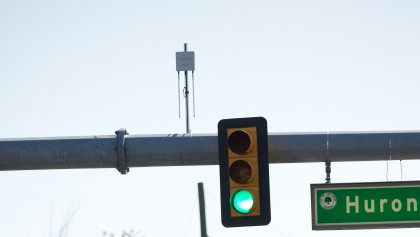The city that's ruled by self driving cars
A place where commuters can read books at the wheel

The future car is coming sooner than you think. Someday, in urban locales like London and San Francisco, incredibly high-tech cars will be connected to each other, the roadway, and to a command center that works like an air traffic control tower.
You'll take your hands off the wheel and take a nap during a morning commute. Crashes and pile-ups will be so unusual they will make national news - the entire car ecosystem will be computer controlled.
The burning question, then is: how will we ever reach this future state?
It was announced last week that the UK government will begin testing driverless car technology later this year. And many car brands like Volvo are busy building their own autonomous auto tech.
But for many drivers, the reality of a morning commute is that there are still mechanical breakdowns, construction delays, and frequent accidents.
Technical advancements like adaptive cruise control and lane departure intervention show promise in cars like the Nissan Infiniti Q50 we looked at last month, but driving is still mostly a human endeavor.
That's changing one car at a time on a stretch of roadway in Michigan, USA. Set to complete next month, a vehicle-to-vehicle test started last August and involves 2,850 cars from various car makers including Ford, GM, and Toyota.
Sign up for breaking news, reviews, opinion, top tech deals, and more.
TechRadar has exclusive early results from the test and visited the actual segment of roadway just outside of Detroit.
Testing Area and Pilot
The northwest corner of Ann Arbor, Michigan looks like any other small town in the world. There are major highways connected to densely-populated urban streets. Traffic slows and stalls as expected, and the green roadside signs look no different from any US city.

Driving in the area, you won't notice any indicators that the US Department of Transportation (DOT) granted the University of Michigan a $14.9M contract to test V2V. There are tree-lined streets, cars that look indistinguishable in every way, and there's even construction.
But look a bit further and you will see the tell-tale signs: antennas attached to bridges and on the roadside that look a bit like high-powered Wi-Fi hotspots you'd find at the mall or corporate office. Cars, trucks, and even mass transit buses tap into the network as they drive the 73 "lane-miles" of the route over the northeast corner of the city. (A lane mile is one 12-foot lane, which can include multiple lanes on one highway or city street.)

Inside the vehicle, there is a basic safety message indicator (BSM) that works like a black box of safety information, feeding real-time stats to every car in the fleet.
"Arbor was carefully selected for this [test]," says Mike Shulman, technical leader in Ford's Active Safety Research and Innovation department. "There is a great diversity in roadway conditions, including highways, overpasses, roundabouts, simple and complex intersections, suburban subdivisions, schools, hospitals, and shopping centers.
This allowed us to test the system under a wide variety of conditions in a small geographic area."
Shulman says the wireless signal uses a modified version of Wi-Fi called 802.11p and a transmission signal called DSRC (dedicated short-range communication).
"
Each vehicle transmits its position, speed, heading, brake status, path history, and path prediction ten times per second for precise safety guidance, like a Twitter feed for cars
"
The signal is encrypted so that only vehicles with the BSM can receive and interpret the data. Each vehicle transmits its position, speed, heading, brake status, path history, and path prediction ten times per second for precise safety guidance -- like a Twitter feed for cars.
The underlying idea with the V2V test is to find out whether a government-empowered safety system helps reduce accidents. This is not the same as the safety measures already inside a luxury sedan like the 2013 Audi S6, which can read roadside lane markings and apply the brakes if a sensor detects you are getting too close to a Fed Ex truck ahead.

John Brandon has covered gadgets and cars for the past 12 years having published over 12,000 articles and tested nearly 8,000 products. He's nothing if not prolific. Before starting his writing career, he led an Information Design practice at a large consumer electronics retailer in the US. His hobbies include deep sea exploration, complaining about the weather, and engineering a vast multiverse conspiracy.